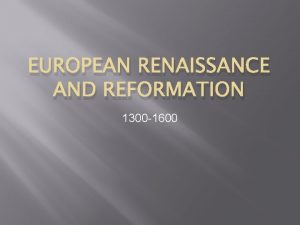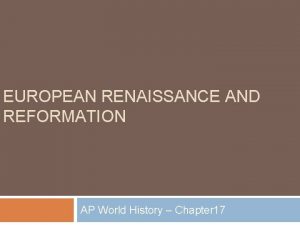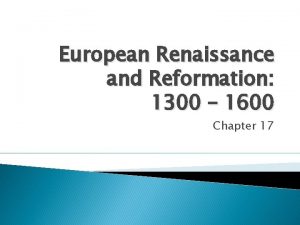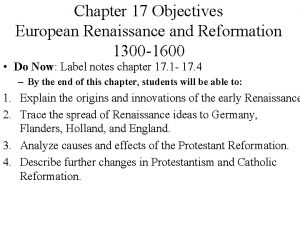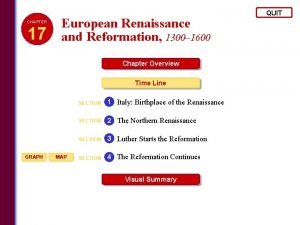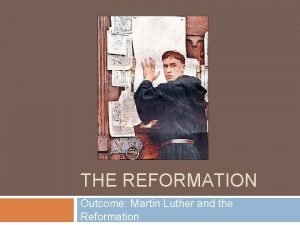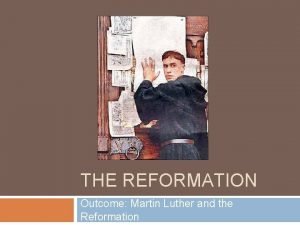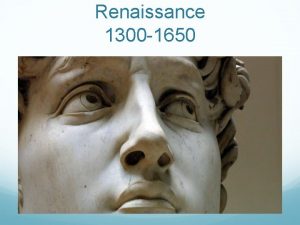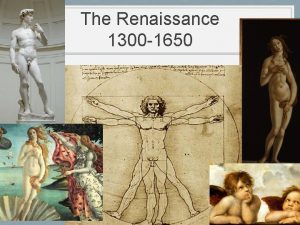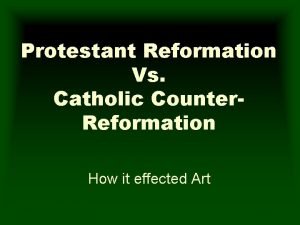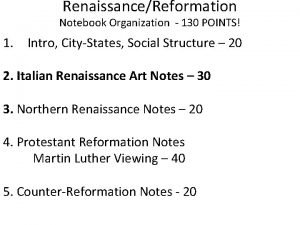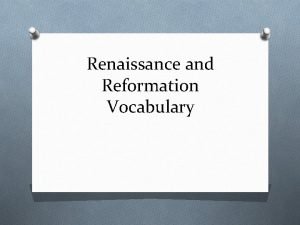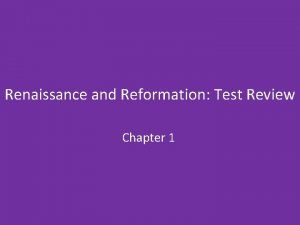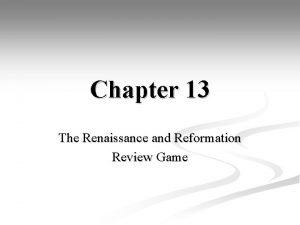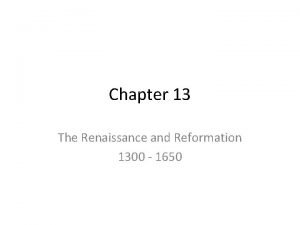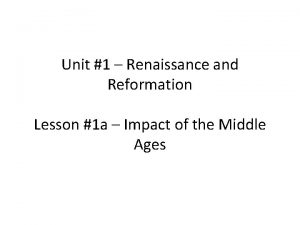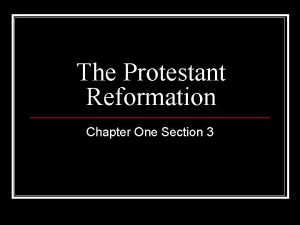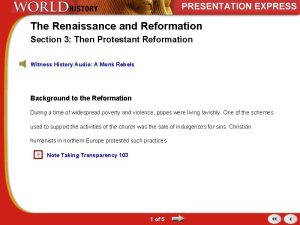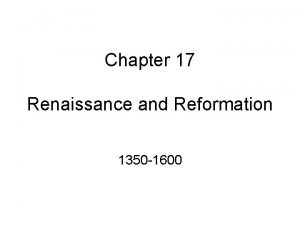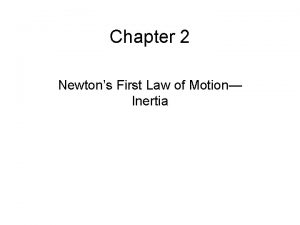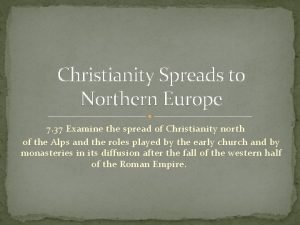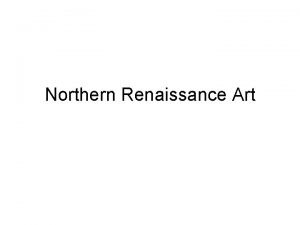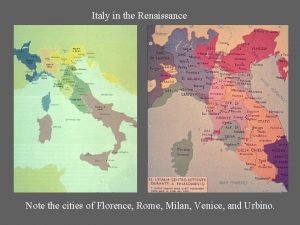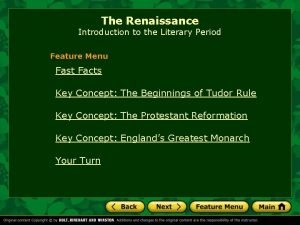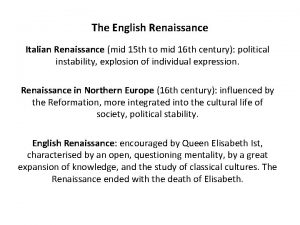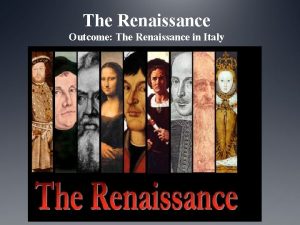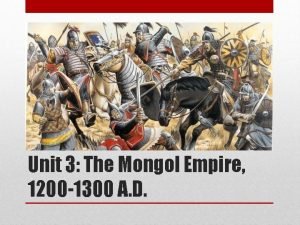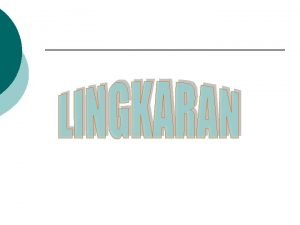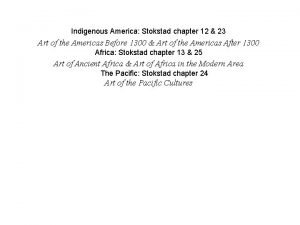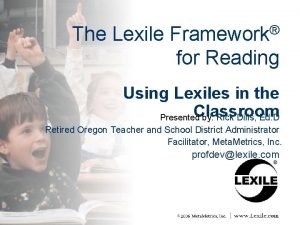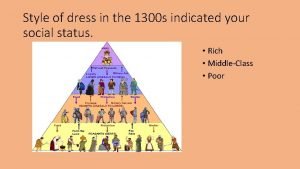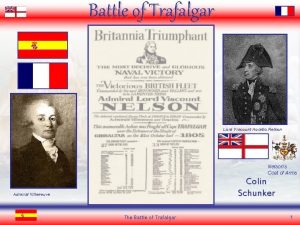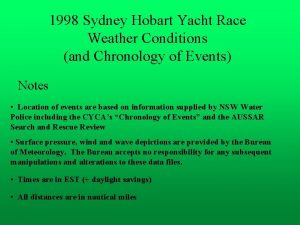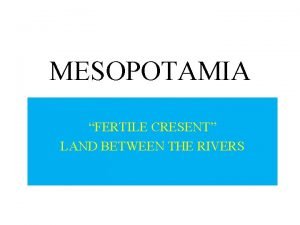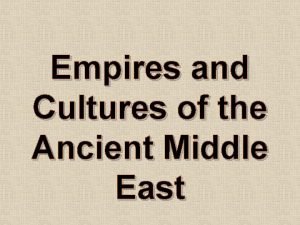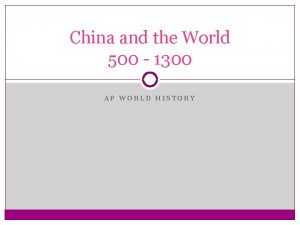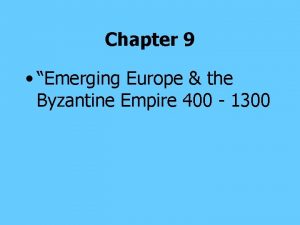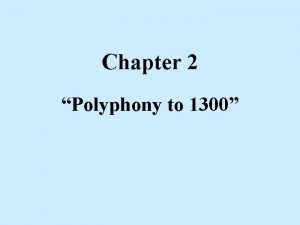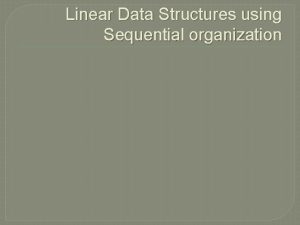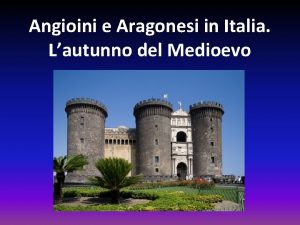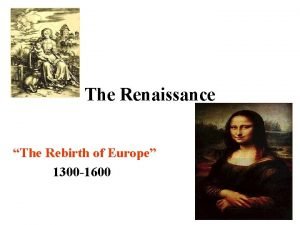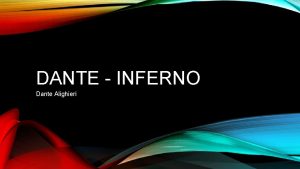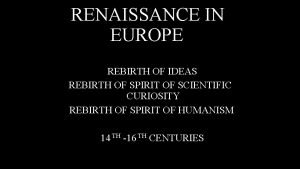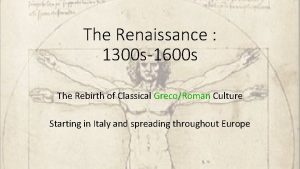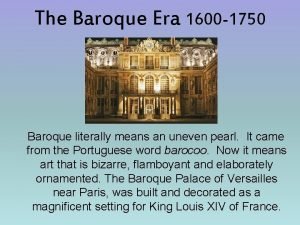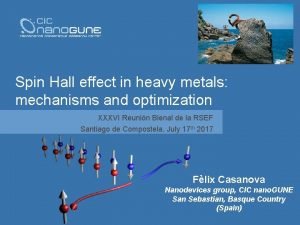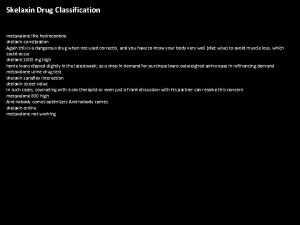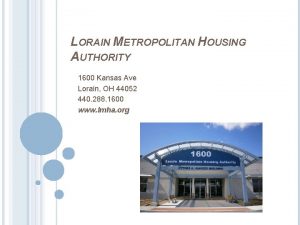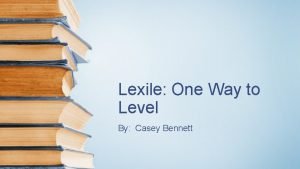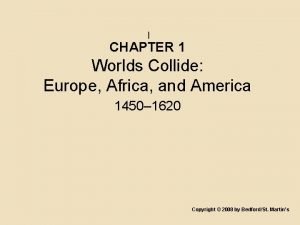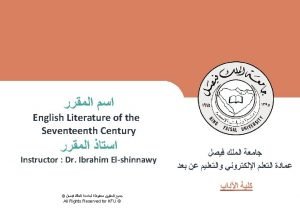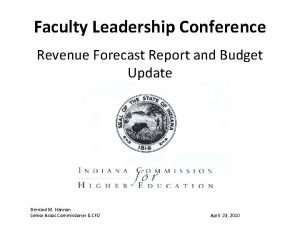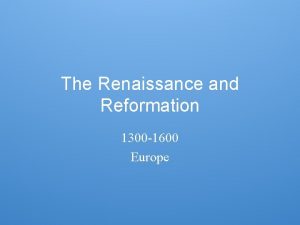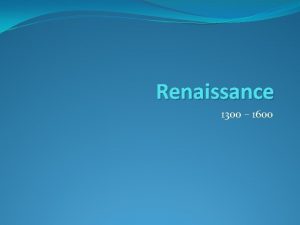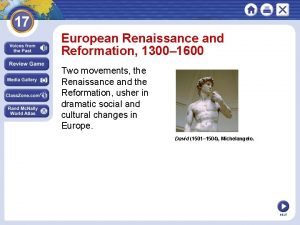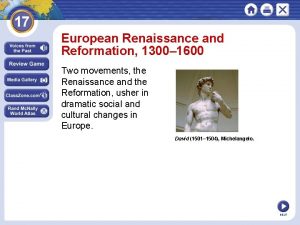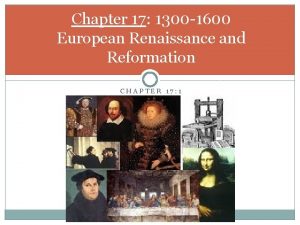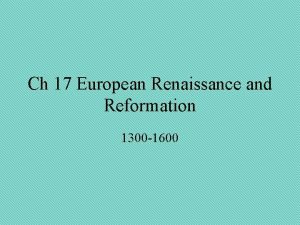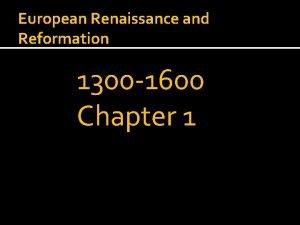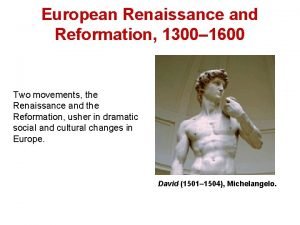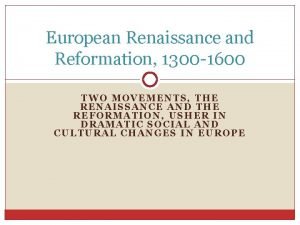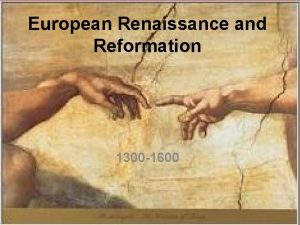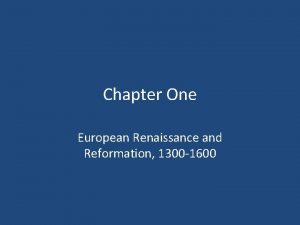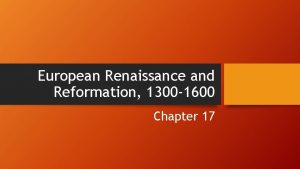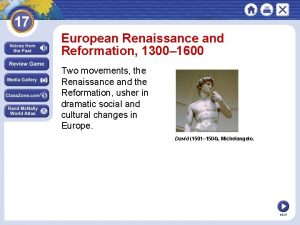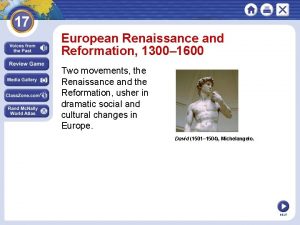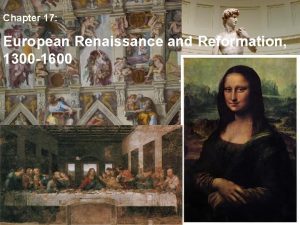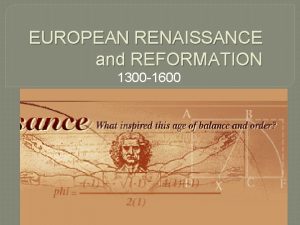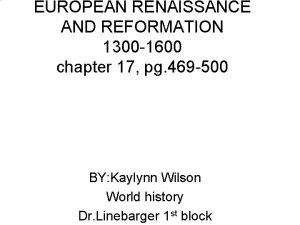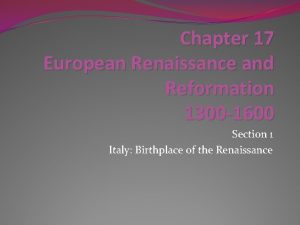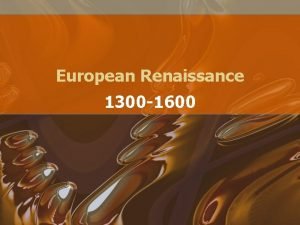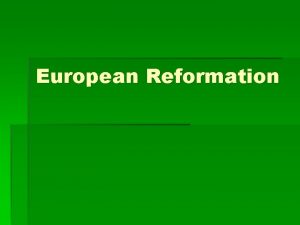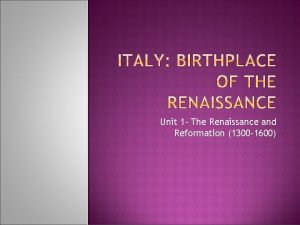EUROPEAN RENAISSANCE AND REFORMATION 1300 1600 EQ WHAT

































































- Slides: 65

EUROPEAN RENAISSANCE AND REFORMATION 1300 -1600

EQ: WHAT WAS THE “RENAISSANCE”? WHAT WERE THE CHARACTERISTICS AND OUTCOMES OF THE RENAISSANCE (ITALIAN)?

What was the Renaissance? The Renaissance was a cultural movement and a time of renewal in the arts and learning (Europe was recovering from the Dark Ages and the Black Death/Bubonic Plague) Renaissance means “rebirth”

Where did the Renaissance begin? • Northern Italy • Cities: • Major Trading Centers

Major Italian City-States Milan One of the richest cities, it controls trade through the Alps. Venice Located on the Adriatic Sea, it is a major trade route between Asia & Europe. Florence Controlled by the Medici Family, who became great patrons of the arts. Milan Venice Genoa Florence Genoa Had Access to Trade Routes Rome Headquarters of the Catholic Church All of these cities: • Had access to trade routes connecting Europe with Middle Eastern markets • Served as trading centers for the distribution of goods to northern Europe Rome

Why does it begin in Italy? � Thriving city-states Grew due to trade beginning during the crusades � Plague killed off laborers, rest get paid more � � Wealthy merchant class � � � Become patrons of the arts Example: Florence controlled by the Medici family Classical heritage of Greece and Rome � Leads to Humanism

Humanism � � Intellectual movement that focused on human potential and achievements Importance placed on education � Study of the humanities: history, literature, philosophy � � Most people still Catholic but movement becomes more secular (worldly) Plays a large role in the arts, literature and politics…

Renaissance art and literature focused on the importance of people and nature, along with religion

David Michelangelo created his masterpiece David in 1504. The Biblical shepherd, David (who killed Goliath) recalls the harmony and grace of ancient Greek tradition

Sistine Chapel About a year after creating David, Pope Julius II summoned Michelangelo to Rome to work on his most famous project, the ceiling of the Sistine Chapel. Depicts the biblical history of the world from the Creation to the Flood

Creation of Eve Separation of Light and Darkness Creation of Adam The Last Judgment

1452 -1519 Painter, Sculptor, Architect, Mathematician, Engineer

The Last Supper (1495 -1498) Mona Lisa (1503 -1506)

Raphael 1483 -1520 School of Athens

Analyzing Art Activity

Artistic Women � Sofonisba Anguissola � 1556 � Self-portrait Artemisia Gentileschi � 1638 -39 self-portrait

Renaissance Literature � Increased writing in vernacular (native language, not Latin) � More writing for self-expression or to portray individuals � Francesco Petrarch “Father of Renaissance Humanism” : caused others to write � Sonnets � in Italian Vittoria Colonna: poems, personal emotion

Political Ideas of the Renaissance Niccolò Machiavelli (1469 -1527) An Italian Philosopher and Writer based in Florence during the Renaissance The Prince (Published in 1532) Machiavelli believed: “One can make this generalization about men: they are ungrateful, fickle, liars, and deceivers, they shun danger and are greedy for profit” Machiavelli observed rulers and produced guidelines for how to gain and maintain power. *Absolute Rule* He felt that a ruler should be willing to do anything to maintain control without worrying about conscience.

Better for a ruler to be feared than to be loved Ruler should be quick and decisive in decision making � Ruler keeps power by any means necessary � The end justifies the means � Be good when possible, and evil when necessary � � Today, the term “Machiavellian” refers to the use of deceit in politics

Write it… � In your opinion is it better to be loved or feared? Why?

Chart the EQ � What was the “Renaissance”? What were the characteristics and outcomes of the Renaissance (Italian)?

Homework � � Main Idea Questions 3 -5 on page 43 Make sure you answer them completely

EQ: HOW DID THE ITALIAN RENAISSANCE SPREAD THROUGHOUT NORTHERN EUROPE?

Renaissance finally moved North � Why? � 1453: Hundred Years War ends Populations began to grow and # of wealthy people increased � Rulers of England France served as patrons bringing ideas north � Invasion of N. Italy in the late 15 th c sent many Ren. Artists north

Since antiquity it had been scribes and later, monks in the Medieval period, who copied all manuscripts by hand … UNTIL … Johann Gutenberg invented a “printing press” – or, the technique of printing from movable blocks of type letters. (1440 ish) *Copying now became mechanized and much faster. 1 st printed: Bible (1455) *Easier exchange ideas, increased literacy The Printing Press spreads Ideas PP Design of T. Loessin; Akins High School

Albrecht Durer – produced woodcuts and engravings whose realism influenced other northern artists. His works were not just religious subject matter but showed classical mythology and realistic landscapes. “Knight, Death, and the Devil” -engraving by Albrecht Durer PP Design of T. Loessin; Akins High School

Jan van Eyck – developed new creative techniques to achieve most realistic detail with oil-based paints, applying several layers to create variety of colors and 3 -D appearance to clothing / jewelry. “Wedding Portrait” * -Jan van Eyck PP Design of T. Loessin; Akins High School

Difference between the Italian and Northern Renaissance � Northern Renaissance thinkers merged humanist ideas with Christianity � Christian Humanism- focus to reform society, promote education, critical of Church failure to inspire people to live a Christian Life � Art and literature tended to still reflect and deal with religion….

Desiderius Erasmus 1466 -1536 Wrote “The Praise of Folly” which poked fun at people’s human flaws; wanted the Bible printed in the vernacular -such as greedy merchants, arrogant priests, etc. -believed mankind could improve society by reading the Bible and that Christianity was about “the heart” and not a bunch of “rules and ceremonies” done in Church. “It is the chief point of happiness when a man is willing to be what he is not what others would have him be. ” ~ Erasmus, 1527. PP Design of T. Loessin; Akins High School

Sir Thomas More (1478 -1535) English Humanist Wrote: Utopia About a perfect society, everyone lives in harmony, no private property, no one is lazy, all are educated and the justice system is used to end crime instead of executing criminals Beheaded in 1535 at the Tower of London on the orders of Henry VIII

DO YOU THINK A UTOPIA IS POSSIBLE? WHY OR WHY NOT?

William Shakespeare 1564 -1616 Renaissance ideas hit England in the mid-1500 s � English poet and playwright � Enters � London 1592 Well-known plays include: Hamlet, Macbeth, Romeo and Juliet, King Lear � Influence and Impact on the Renaissance: � He expanded the dramatic potential of characterization (his characters were very complex), plot, language (creative), and genre

Christine de Pizan 1364 -1430 � � Called for female education Wrote The Book of the City of Ladies � Accomplishments of great women

Legacy of the Renaissance � � Belief in the dignity of the individual played a key role in the rise of democratic ideas Changes � More realism � Secular as well as religious � Vernacular used more often � Increased literacy � Published laws make law clearer � People began to question political and religious structures

TOTD � EQ: How did the Italian renaissance spread throughout northern Europe?

EQ: WHY DID MARTIN LUTHER PROTEST AGAINST THE CATHOLIC CHURCH AND WHAT WAS THE OUTCOME OF HIS PROTEST?

Causes of the Protestant Reformation � � Social: renaissance rise of humanism and secular ideas; printing press spread ideas Political: powerful monarchs challenged the church; pope seen as a foreign ruler and challenged his authority Economic: jealous of church’s wealth; people resented paying taxes to the church Religious: corruption; some saw the sale of indulgences as unacceptable

VLived 1483 -1546 in Germany VFather encouraged him to study law VA sudden religious experience inspired him to become a monk

VHe became troubled over the possibility of not going to heaven and turned to the Bible, and confession for comfort V 1517 - troubled by the sale of indulgences that were giving people the idea that they could buy their way into heaven

Luther Looks for Reforms � � � Luther criticized Church practices, like selling indulgences. He wanted a discussion within the Church about the true path to salvation. He nailed his Ninety-Five Theses, or arguments, to the door of Wittenberg cathedral for all to see. (Oct 31, 1517) Actions begin the Reformation!

Protestant Teaching: Justification by Faith Alone � � Luther’s Bible People can read and understand the Bible-only source of truth Salvation comes only through faith in Christ.

Excommunication � � � Pope Leo X demanded that Luther recant 41 of his Ninety-Five Theses. Luther was brought before the Diet of Worms and found guilty; Edict of Worms declared him a heretic and denied him shelter In January 1521, Luther was excommunicated from the Church.

Religious Fighting � � � 1524 - German peasants demand end to serfdom. Luther spoke against peasants raiding monasteries and fighting breaks out 1529 - Catholic German princes agree to join forces against protesting princes who support Luther (become known as Protestants) The first wars ended with the Treaty of Augsburg (1555): princes decide religion for their state Saint Bartholomew’s Day massacre

The Reformation spread to other countries. France and Switzerland: John Calvin preached the idea of “predestination” and that some people had been chosen by God for salvation. � England: King Henry VIII refused to recognize the Roman Catholic Church and started a new church, the Church of England. �

Activity: England becomes Protestant � � � � Using your textbook (pages 58 -60) create a timeline using 6 of the following dates that you believe had an impact on England becoming a protestant nation. For each date note its significance in as few words as possible (you must still be able to understand why the date is important) 1509 1521 1536 1527 1537 1529 1547 1533 1553 1534 1558 1535 1559

Timeline of English Reformation � � � � 1509: Henry VIII becomes king 1521: He verbally attacks Luther becomes “Defender of the Faith” 1527: he asks Pope to annul marriage to Catherine; Pope says no 1529: He calls a Reformation Parliament; to end Pope’s power in England 1533: divorces Catherine, marries Anne Boleyn 1534: Act of Supremacy- people to oath recognizing the divorce and accepted King as head of Church of England 1535: Thomas More executed for refusing to sign Act of Supremacy 1536: Anne beheaded 1537: 3 rd wife Jane Seymour has prince Edward and dies 1547: Henry VIII dies; Edward becomes king at age 9 1553: Mary becomes queen; tried to return to Catholicism-kills Protestants 1558: Elizabeth I becomes queen 1559: est. Anglican Church; seeks compromise with Protestants and Catholics

DO YOU THINK LUTHER OR HENRY VIII HAD A BETTER REASON FOR BREAKING WITH THE CHURCH? SUPPORT YOUR ANSWER

TOTD � EQ: Why did Martin Luther protest against the Catholic Church and what was the outcome of his protest?

Brainstorm before you begin: � The Protestant Reformation is sweeping across Central Europe, England, and even Scandinavia! You have been hired by the Pope to develop ideas that the Church can implement in order to stop believers from converting to these heretical faiths. What are your top 2 ideas? Hurry, you must act quickly, or Protestantism may overrun Europe!

EQ: WHAT REFORMS DID THE CATHOLIC CHURCH MAKE IN RESPONSE TO THE CONTINUED PUSH OF THE PROTESTANT REFORMATION?

Spit it Out! � What do you think the term theocracy means?

VAnti-Catholic VInfluenced by Martin Luther VDisagreed with “Salvation through faith alone. ” VCreated his own Protestant religion in Switzerland

VSalvation through Predestination VAt birth it is decided if you will go to heaven or hell VPeople’s nature is sinful

VGod knows everything that will happen in your life VLead a pure life: No drinking, swearing, card playing, gambling etc. .

VStarted in Switzerland – Calvinists VEngland = Puritans VScotland = Presbyterians V John Knox VHolland = Dutch Reform VFrance = Huguenots VGermany = Reform Church

ANABAPTISTS � � “baptize again” as adults Church and state should be separate Pacifists Belief in sharing possessions � Spinoffs- Mennonites, Amish, Quakers, Baptists

The Counter Reformation The Church had two tactics: � Reform the Church from Within � Stop the Spread of Protestantism Council of Trent Water Torture during the Inquisition

Reform Within the Church � The Council of Trent (1545 -1563; called by Pope Paul III) � Purpose: meetings to discuss reform AND define dogma (official teachings) � Some areas were actually reformed Called for the education of priests Improved discipline among the clergy False selling of indulgences banned � But many teachings were not changed, and were instead reinforced; the ideas of the Protestants were rejected You need faith AND good works to achieve salvation Pope is supreme leader Man has free will

Stopping the Spread of Protestantism � The Society of Jesus: The Jesuits �A religious group founded by Ignatius Loyola; in 1540 approved by Pope Paul III (1534 -49) � Promoted education and missionary work � Follow the Pope

Stopping the Spread of Protestantism � Index (List) of Banned Books � Created in 1559 by Pope Paul IV � Purpose was to prevent heresy (opinion at odds with what is generally accepted)

The Inquisition **General purpose was to discover heretics (mostly Jews and Muslims, but also Protestants), reinforce Catholic doctrine, and prove the power of the Church � When? 1400 s-1800 s � Where? Mostly Spain and Italy Across Europe Ironic! � How? The accused were put on trial ; guilty until proven innocent… Torture used

Stopping the Spread of Protestantism The Inquisition often used the Auto-dafe: “Act of Faith”, a public trial that was usually followed by torture or execution

WAS THE COUNTERREFORMATION A SUCCESS? The Church did not win back many of the “lost souls” that had converted to Protestantism… But, it shed its reputation for corruption and it spread widely through missionary work

Write It � What reforms were brought about during the Catholic Reformation (Counter Reformation)?

� � � � Oath of the Jesuits Reading Vocabulary Conducive - making a certain situation or outcome likely or possible Consolation - comfort received by a person after a loss or disappointment. Edification - the instruction or improvement of a person morally or intellectually. Evasion - the action of evading something. Prelate’s - a bishop or other high ecclesiastical dignitary Propagate - spread and promote (an idea, theory, etc. ) widely. Schismatic – A person who promotes a split or division between strongly opposed sections or parties, caused by differences in opinion or belief. Vicar - `(in the Roman Catholic Church) a representative or deputy of a bishop.
 The time of rebirth
The time of rebirth Who wrote praise of folly
Who wrote praise of folly European renaissance and reformation answer key
European renaissance and reformation answer key Chapter 17 european renaissance and reformation
Chapter 17 european renaissance and reformation European renaissance and reformation chapter 17
European renaissance and reformation chapter 17 European renaissance and reformation chapter 17
European renaissance and reformation chapter 17 The reformation outcome: martin luther and the reformation
The reformation outcome: martin luther and the reformation The reformation outcome martin luther and the reformation
The reformation outcome martin luther and the reformation Renaissance timeline 1300 to 1650
Renaissance timeline 1300 to 1650 Borgia and medici timeline
Borgia and medici timeline Catholic reformation vs counter reformation
Catholic reformation vs counter reformation Renaissance historical events
Renaissance historical events Lutheranism and calvinism
Lutheranism and calvinism Renaissance and reformation interactive notebook
Renaissance and reformation interactive notebook Renaissance and reformation vocabulary
Renaissance and reformation vocabulary Renaissance and reformation test review
Renaissance and reformation test review Chapter 13 the renaissance and reformation
Chapter 13 the renaissance and reformation Chapter 13 renaissance and reformation
Chapter 13 renaissance and reformation Unit 4 lesson 1 the renaissance
Unit 4 lesson 1 the renaissance Protestant reformation worksheet answer key
Protestant reformation worksheet answer key Chapter 12 renaissance and reformation worksheet answer key
Chapter 12 renaissance and reformation worksheet answer key The renaissance and reformation section 3 quiz
The renaissance and reformation section 3 quiz Chapter 17 renaissance and reformation
Chapter 17 renaissance and reformation When burl and paul stand on the scaffold
When burl and paul stand on the scaffold Cosimo de' medici
Cosimo de' medici Italian renaissance vs northern renaissance venn diagram
Italian renaissance vs northern renaissance venn diagram The renaissance outcome renaissance painters/sculptors
The renaissance outcome renaissance painters/sculptors Italian vs northern renaissance
Italian vs northern renaissance Renaissance vs high renaissance
Renaissance vs high renaissance The renaissance introduction to the renaissance answer key
The renaissance introduction to the renaissance answer key Italian renaissance vs english renaissance
Italian renaissance vs english renaissance The renaissance outcome the renaissance in italy
The renaissance outcome the renaissance in italy Cambulac
Cambulac Besar sudut pusat segi 12 beraturan adalah
Besar sudut pusat segi 12 beraturan adalah Tentukan besar sudut aob
Tentukan besar sudut aob Art of the americas before 1300
Art of the americas before 1300 Axgate 1300
Axgate 1300 Lexile range by grade level
Lexile range by grade level 1300 dress
1300 dress 1300 hrs
1300 hrs Sydney to hobart 1998 wave height
Sydney to hobart 1998 wave height Who were the babylonians
Who were the babylonians 1300-612 bce
1300-612 bce 1200-1300 lexile books
1200-1300 lexile books Foot binding definition ap world history
Foot binding definition ap world history The byzantine empire and emerging europe
The byzantine empire and emerging europe Notre dame organum
Notre dame organum Linear data structure using sequential organization
Linear data structure using sequential organization Nec ft server
Nec ft server What is a continuous feed printer
What is a continuous feed printer Si concluse nel 1300 02 con la pace di caltabellotta
Si concluse nel 1300 02 con la pace di caltabellotta Renaissance years
Renaissance years Nxamp 4x2 mk2
Nxamp 4x2 mk2 Inferno a bűnös város
Inferno a bűnös város Venetia 1600 births and rebirths
Venetia 1600 births and rebirths Venetia 1600 births and rebirths
Venetia 1600 births and rebirths 1750+1600
1750+1600 Orbitronics batteries
Orbitronics batteries Metaxalone 1600 mg
Metaxalone 1600 mg Emap
Emap International plaza lorain ohio
International plaza lorain ohio 1600 lexile
1600 lexile Abcdarab
Abcdarab Foam pro 1600
Foam pro 1600 Puritan age in english literature
Puritan age in english literature 1600-1329
1600-1329

